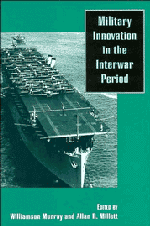Book contents
- Frontmatter
- Contents
- Acknowledgments
- Introduction
- 1 Armored warfare: The British, French, and German experiences
- 2 Assault from the sea: The development of amphibious warfare between the wars – the American, British, and Japanese experiences
- 3 Strategic bombing: The British, American, and German experiences
- 4 Close air support: The German, British, and American experiences, 1918–1941
- 5 Adopting the aircraft carrier: The British, American, and Japanese case studies
- 6 Innovation ignored: The submarine problem – Germany, Britain, and the United States, 1919–1939
- 7 From radio to radar: Interwar military adaptation to technological change in Germany, the United Kingdom, and the United States
- 8 Innovation: Past and future
- 9 Patterns of military innovation in the interwar period
- 10 Military innovation in peacetime
- Index
5 - Adopting the aircraft carrier: The British, American, and Japanese case studies
Published online by Cambridge University Press: 05 August 2012
- Frontmatter
- Contents
- Acknowledgments
- Introduction
- 1 Armored warfare: The British, French, and German experiences
- 2 Assault from the sea: The development of amphibious warfare between the wars – the American, British, and Japanese experiences
- 3 Strategic bombing: The British, American, and German experiences
- 4 Close air support: The German, British, and American experiences, 1918–1941
- 5 Adopting the aircraft carrier: The British, American, and Japanese case studies
- 6 Innovation ignored: The submarine problem – Germany, Britain, and the United States, 1919–1939
- 7 From radio to radar: Interwar military adaptation to technological change in Germany, the United Kingdom, and the United States
- 8 Innovation: Past and future
- 9 Patterns of military innovation in the interwar period
- 10 Military innovation in peacetime
- Index
Summary
In World War II, aviation had a decisive effect on the outcome of the naval campaigns against the Axis powers. Carrier and land-based maritime aircraft vastly extended reconnaissance at sea, offered the most effective means of protecting shipping – merchant as well as military – against air and submarine attack, and proved to be a potent means of attack on enemy warships and maritime commerce. Sea-based aircraft were essential for the conduct of amphibious operations because they were the principal means of attacking defensive aircraft and of securing command of the air. Carrier aircraft protected amphibious shipping and troops ashore and provided reconnaissance and fire-support facilities that were often decisive.
However, in the years between the wars, the British, American, and Japanese navies failed to realize fully the contribution that airpower could make to the conduct of war at sea. Policy makers, in all three navies, underestimated the extent to which naval airpower represented a significant departure in the way they would conduct their business.
Nonetheless, the following analysis will show that by the outbreak of World War II, the three navies differed only in the degree of their underestimation of the strategic significance of maritime air power. The British were the least perceptive, the Japanese, the most. But the differences among them, and indeed between them and other major navies not included in this review, were matters of degree, not a question of absolutes.
- Type
- Chapter
- Information
- Military Innovation in the Interwar Period , pp. 191 - 226Publisher: Cambridge University PressPrint publication year: 1996
- 4
- Cited by

